New York Architecture Images
new york architecture walks- upper east side
|
Start:
The southeast corner of Central Park, at 59th Street and Fifth Avenue.
Subway: Take the N or R to Fifth Avenue. Finish: 91st Street and Fifth Avenue. Time: Approximately 3 hours. Best Time: Weekday afternoons, when museums and restaurants are open but not as crowded as on Saturdays. Worst Time: Sundays, when most stores and galleries are closed and the streets seem deserted. The Upper East Side Over a century ago, society watchers predicted that the wealthy and fashionable would settle permanently on the avenues bordering Central Park. Time has proven them right. Fifth Avenue north of Grand Army Plaza, which lies at the southeast corner of the park, is officially called Museum Mile. But the magnificent private mansions built here in the first few decades of this century by some of America's wealthiest industrial tycoons also earned it the title of Millionaires' Row. Judging from old photos, it was something to behold. Today, patrician mansions still stand along the avenue, though others have ceded their coveted real estate to large apartment houses. But the age of imperial living isn't over by any means. Some of the buildings on Fifth Avenue (as well as on Park Ave. and elsewhere on the East Side) contain apartments every bit as palatial and sumptuous as the vanished mansions. Even New Yorkers are surprised to hear of apartments with 20, 30, or even 40 rooms, but they do exist in this neighborhood. Start your tour where Fifth Avenue and 59th Street meet at: |
|
|
1. Grand Army Plaza--The
plaza is adorned with a brilliant gold statue of William Tecumseh
Sherman, the ruthless but effective Civil War general who devastated the
Southern countryside and brought the civilian population to its knees
with the Union army's scorched-earth March to the Sea. Created by
Augustus Saint-Gaudens, it's a classical equestrian statue of the crusty
general with a female Winged Victory striding along in front of the
horse.
Now stroll up Fifth Avenue, staying on the park side of the street for the best view of the buildings as you pass. In good weather, bookstalls from The Strand line the sidewalk, full of used volumes at a fraction of the cover price. On the east (right) side of Fifth Avenue, at 61st Street, is: |
|
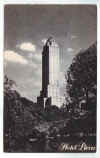 |
Hotel Pierre |
|
2. The Pierre--This
has been one of Manhattan's priciest and most exclusive hotels since its
opening in 1930. In 1932, mystery writer Dashiell Hammett stayed here
while working on The Thin Man, though, unfortunately, he couldn't
pay the bill that he had run up during his stay. He allegedly donned a
disguise to sneak out without settling his tab.
At the southeast corner of 62nd Street stands the third home of the: |
|
 |
Knickerbocker Club |
|
3. Knickerbocker Club--This
club looks a lot like the big private houses that once characterized the
avenue. The Georgian brick Knickerbocker, completed in 1915, was the
work of a firm called Delano and Aldrich, a favorite of high society in
the early 20th century. It retains a very pedigreed image. Ernest
Hemingway, looking for peace and quiet, rented an apartment here in 1959
and stayed for about a year.
The next block up is 63rd Street. On the east corner you'll see: |
|
|
4. 820 Fifth Ave.--This
is one of the earliest apartment houses built hereabouts and still one
of the best. Built in 1916, it has only one apartment on each floor,
with five fireplaces and seven bathrooms in each one.
Continue northward on Fifth Avenue to 64th Street. Walk just inside Central Park for a look at: |
|
 |
The Arsenal |
|
5. The Arsenal--Built
in 1848 when this neighborhood was distant and deserted, the Arsenal now
houses zoo administration offices. The structure was once a bunkhouse
and weapons depot for Civil War troops (notice the railing made of
rifles). The Central Park Zoo is right behind the building.
Head back onto Fifth Avenue. Opposite the park at the southeast corner of 64th Street (828 Fifth Ave.) is the former mansion of coal magnate Edward Berwind. This residence dates from 1896 and has been preserved as cooperative apartments. Head east (away from the park) on 64th Street toward Madison Avenue. This particularly handsome East Side block is lined with architectural extravaganzas. Note in particular: |
|
|
6. 3 E. 64th St.
This opulent beaux arts mansion was built in 1903 for the daughter of Mrs. William B. Astor. The house was designed by Warren and Wetmore, the firm responsible for Grand Central Terminal, and it now houses the Consulate General of India. Also worthy of admiration on this block are nos. 16, 19 (now home to a Wildenstein Gallery open Mon-Fri 10am-5pm), and 20. At Madison Avenue, turn left and saunter two blocks north to 66th Street. Note the rather fantastic apartment house built in 1900 on the northeast corner of 66th and Madison, and then turn left (west) off Madison onto 66th Street, heading back toward Fifth Avenue. Among the many notable houses on this block is the magnificent French Renaissance-style house at 5 E. 66th St., with its heavy wooden doors and elegant stonework detail. Built in 1900, it's now home to the Lotos Club, which is dedicated to literature and the fine arts. Next door, at 3 E. 66th St., is the: |
|
|
7. Home of President Ulysses S.
Grant--Grant lived here from 1881 to 1885.
Forced to declare bankruptcy after a disastrous presidency that was
marred by scandal, the former Civil War hero retired here to spend his
last years penning his memoirs. Though he was battling cancer, Grant
managed to hang on just long enough to complete the autobiography, which
won favorable literary reviews and earned his family half a million
dollars.
Now double back to Madison Avenue, turn left, and continue north for two more blocks, stopping to browse in any of the boutiques that catch your eye. There's Nicole Miller; La Perla for lovely lingerie; Emanuel Ungaro; Godiva, where you can treat yourself to some coffee and a decadent truffle; and Berk for cashmere. At 68th Street, turn right (east) toward Park Avenue. One of the best houses on this block is: |
|
|
8 58 E. 68th St.--Located
on the southwest corner of the intersection with Park Avenue, this house
was built in 1919 for Harold J. Pratt, son of Rockefeller partner
Charles Pratt.
Walk to the north side of 68th Street to: |
|
|
9. 680 Park Ave.--This
neo-Federal town house was built from 1909 to 1911 for banker Percy
Rivington Pyne and designed by McKim, Mead, and White. Its style and
architecture were copied all along this Park Avenue block. When, from
1948 to 1963, it housed the Soviet Mission to the United Nations,
Premier Nikita Khrushchev waved to curious crowds from the balcony
during his famous shoe-banging visit to the U.N.
The Marquesa de Cuevas bought 680 Park Ave. in 1965, staving off a slated demolition by presenting it to the Americas Society, devoted to educating U.S. citizens about their Western Hemisphere neighbors. The society sponsors public art exhibitions and cultural programs on Latin American and Canadian affairs. The other buildings on this block house the Spanish Institute and the Italian Institute. Head north on Park Avenue to 69th Street. On the northeast corner stands the: |
|
 |
Union Club |
|
10. Union Club--The
Union Club was designed in 1932 to house New York's oldest club. On the
other side of 69th Street is Hunter College. Turn right onto 69th Street
and continue east toward Lexington Avenue, noting en route 117 E. 69th
St., a prototypical, not-so-small, private East Side house with
beautiful stained-glass panels around the door.
When you arrive at Lexington Avenue, detour right a few steps to a still-operating branch of Shakespeare and Co. (no. 939), Manhattan's famously literary bookseller whose West Side main branch was put out of business in 1996 when Barnes and Noble strategically built two megastores within walking distance. Double back up Lexington 1 1/2 blocks uptown to 70th Street. Turn left and head back toward Park Avenue along: |
|
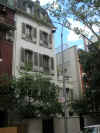 |
Paul Mellon House |
|
11. E. 70th Street
This street presents a succession of elegant houses, each more beautiful than the next. Some consider this the finest street in New York. Note in particular no. 125, a post-World War II mansion built for Paul Mellon in a French provincial style. When you arrive at the Park Avenue end of the block, note the modern building on the northeast corner, which houses the: |
|
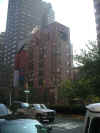 |
Asia Society |
|
12. Asia Society--The
Asia Society (tel. 212/288-6400 or 212/517-ASIA;
www.asiasociety.org) offers workshops, lectures, films, and performances
on Asian culture. Major art exhibitions, both ancient and contemporary,
are held in the galleries.
Cross Park Avenue and note 720 Park Ave. on the northwest corner of the intersection. This building is a prime example of the sort of swanky, enormous apartment building that lured former mansion dwellers away from their private houses. The upper stories of buildings like no. 720 often contain apartments with three or four floors and dozens of rooms. Continue on East 70th Street, crossing Madison, toward Fifth Avenue. Two of the Upper East Side's premier art galleries are along 70th Street. |
|
|
13. Hirschl and Adler--Located
at no. 21 (tel. 212/535-8810;
www.hirschlandadler.com
), Hirschl and Adler shows quality works of American and European art in
many media ranging from the 18th century to current day masterpieces.
Next door, at no. 19, is Knoedler and Company (tel. 212/794-0550), a major gallery for established American artists such as Helen Frankenthaler, Adolph Gottlieb, Nancy Graves, Frank Stella, and John Walker. Nearing Fifth Avenue, you'll pass a lovely courtyard and lily pond, surrounded by stately black iron gates, before reaching the entrance to my favorite New York museum, the: |
|
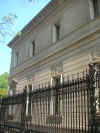 |
Frick Collection |
|
14. Frick Collection
This collection (tel. 212/288-0700; www.frick.org ) is housed in the 1914 mansion of steel magnate Henry Clay Frick and very evocative of the Gilded Age. The beautiful classic garden overlooking 70th Street was built in 1977. Frick always intended that his art collection be opened to the public after his death. The works are arrayed in rooms, many with Frick's original furnishings, centered around a small, plant-filled atrium with classical styling, a vaulted skylight, and a softly splashing fountain. If you have time for only one museum on this tour, the modestly sized but rich Frick Collection may be your best choice. Turn right at the corner of Fifth Avenue, passing a beautiful colonnade on the side of the Frick building. Continue two blocks north, and turn right onto 72nd Street, heading toward Madison Avenue. On your left, at no. 9, is the Lycée Français (a French primary and secondary school), housed in an elaborate 1894 building of the late French Renaissance style. At the southeast corner of 72nd Street and Madison is: |
|
 |
Polo/Ralph Lauren |
|
15. Polo/Ralph Lauren--This
showcase store, housed in a renovated mansion that dates from 1895,
looks for all the world like an English country mansion inside, complete
with working fireplaces, Persian rugs, antiques, and a grand baronial
staircase. Closed Sunday.
Take Madison Avenue up a block to 73rd Street, passing The Sharper Image (no. 900), the catalog store for the gadget-hound in all of us, and Yumi Katsura (no. 907), a boutique showcasing exquisite wedding gowns for the well-to-do bride. Detour to your left on 73rd Street to see: |
|
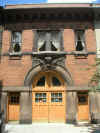 |
East 73rd Street |
|
16. 11 E. 73rd St.--This
particularly sumptuous house was built in 1903 by McKim, Mead, and White
for Joseph Pulitzer, the Hungarian-born publisher of a once-famous but
long-vanished newspaper called the New York World. Pulitzer
rarely lived in this house because of his extreme sensitivity to sound.
At one time, it contained a special soundproof room (mounted on ball
bearings to prevent vibrations, no less). When he died in 1911, Pulitzer
bequeathed $2 million to the Columbia Graduate School of Journalism,
whose trustees bestow the Pulitzer Prizes, annual awards for outstanding
achievement in journalism, literature, drama, and musical composition.
Retrace your steps back to Madison Avenue and turn left. At the southeast corner of 75th and Madison you'll see the: |
|
 |
Whitney Museum of American Art |
|
17. Whitney Museum of American Art--Housed
in a 1966 architectural masterpiece by Marcel Breuer, the Whitney (tel.
212/570-3676;
www.whitney.org) contains an impressive collection of 20th-century
American art, with paintings that reflect trends from naturalism to pop
art and abstract expressionism. Roy Lichtenstein, Georgia O'Keeffe,
Edward Hopper, and Jasper Johns are just a few of the artists
represented here. Hours are Tuesday, Wednesday, Thursday.
Take a Break--In the museum's basement, Sarabeth's at the Whitney (tel. 212/570-3670) is much more than your average museum cafeteria--and more expensive, with main lunch dishes starting at $13.70 and brunches starting at $6.75--but it's delicious! Leave the museum and continue uptown on Madison Avenue. At 76th Street, you'll pass one of New York's grand old hotels, the Carlyle, which has counted two presidents (Harry Truman and John F. Kennedy) among its famous guests. The west side of Madison Avenue from 76th to 77th streets is lined with a procession of intriguing contemporary art galleries, including the Gagosian Gallery in the penthouse of no. 980 (20th-century artists, including Frank Stella, Richard Serra, Andy Warhol, Mark di Suervo, Chris Burden, and Walter de Maria) and David Findlay at no. 984 (19th- and 20th-century American and European art). On the way to 79th Street, you'll also run into the French gourmet store Fauchon (no. 1000) which boasts a stand-up coffee bar and a menagerie of pastries (all pastry ingredients are French-imported, down to the water). Turn left when you reach 79th Street and return to Fifth Avenue. The impressive row of buildings includes everything from French château-style structures to neo-Georgian town houses. When you reach the corner of Fifth Avenue, turn left for a look at: |
|
|
18. 972 Fifth Ave.--Located
between 78th and 79th streets, this building now serves as the French
Embassy's Cultural Services Office, but it was built in 1906 as a
wedding present for Payne Whitney by his doting (and childless) rich
uncle, Oliver Payne, a Civil War officer and one of the benefactors who
helped to found Cornell's Medical College. This McKim, Mead, and White
opus cost $1 million and was the talk of the town in its day. Step
inside for a glance at its neoclassical rotunda. The broken statue on
the central pedestal is a replica of one that caused quite a stir in
1995 when a passing art historian pegged it as a long-lost work by
Renaissance master Michelangelo. For years having served as a fountain
spout, the suddenly famous Cupid (or, depending on who you ask, perhaps
a young Apollo or a young archer) sculpture was spirited away until the
controversy over its attribution is resolved. Some claim it was by
Michelangelo's teacher Bertoldo; others claim that it's a 19th-century
fake.
Next door, on the corner of 78th Street, is the classic French-style mansion of tobacco millionaire James B. Duke (as in Duke University). His daughter Doris occupied the house intermittently until 1957, when she donated it to New York University. NYU now operates it as a fine arts institute. Now turn around and walk north on Fifth Avenue. On your left at 82nd Street is the grand entrance to the: |
|
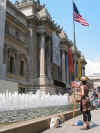 |
Metropolitan Museum of Art |
|
19. Metropolitan Museum of Art--The
Met (tel. 212/535-7710;
www.metmuseum.org
) is one of the world's greatest cultural institutions. The block of 82nd
Street that faces the museum's mammoth staircase almost acts as a sort
of formal court. The museum's collection is enormous--the largest in the
Western Hemisphere--and includes an Egyptian wing that boasts tens of
thousands of objects. Its Temple of Dendur, circa 15 B.C. from Lower
Nubia, was shipped piece by piece to the Met and painstakingly
reconstructed. It would take a lifetime to see all of the Met's
treasures, so it might be best to save it for another day and merely
admire the exterior for now.
Continue uptown past 85th Street. The building at 1040 Fifth Avenue was for many years the: |
|
|
20. Home of Jacqueline Kennedy Onassis
After her first husband's assassination, she moved here so that Caroline could attend school at nearby Sacred Heart. The former first lady adored New York and was often spotted strolling nearby in her beloved Central Park. After her death from cancer in 1994, hundreds of mourners gathered outside this building, many leaving flowers on the sidewalk in her memory. Continue uptown to: |
|
|
21. 86th Street--The
brick and limestone mansion on the southeast corner of Fifth Avenue and
86th Street was built in 1914 for William Star Miller, but was more
famously the home of Grace Vanderbilt, once known as the Queen of
America's High Society. Grace Graham Wilson was the daughter of a
southern Civil War profiteer who moved north and carefully stitched his
family into New York High Society. Grace was first engaged to the
Vanderbilt's eldest son, William Henry II, but he died in 1892. Then she
was betrothed to Cecil Baring--until Baring Bank crashed in 1893 and she
broke it off. It's no wonder, then, that the Vanderbilts sniffed a gold
digger in the socialite, and when their now-eldest son and heir-apparent
Cornelius III became engaged to her as well, they promptly refused their
permission. In fact, some historians attribute Cornelius II's disabling
1896 stroke to the result of an argument with his son over the impending
marriage. When the younger Cornelius still would not relent, his father
disinherited him as primary heir. Cornelius III's brothers were more
forgiving, however, and redistributed the inheritance more equally than
the will called for after their father's death.
The intelligent Cornelius III went on to grow his wealth through his love of science--he was a consulting engineer on New York's first subway system--and Grace became the primary New York hostess for almost every visiting monarch and merchant-prince. They moved into a mansion at 640 Fifth Avenue, built in the 1880s by Cornelius III's grandfather William Henry I, which was located down on 51st Street and was the first of a concentration of family houses that at the turn of the 20th century caused Fifth Avenue to be called "Vanderbilt Alley." Despite losing over $8 million in the Great Crash of 1929, the Vanderbilts foolishly maintained their lavish lifestyle throughout the Depression. By the end of the 1930s they were, for Vanderbilts, nearly broke (by which I mean they only had $4 million to spare). They had also become pretty much isolated down around 51st Street, surrounded by ghosts of the Vanderbilt past, lots of noisy traffic, and the new office buildings that had replaced many of the other Millionaire's Row mansions done in by the Depression. Grace and her husband ended up having to sell the 640 Fifth Avenue house, and Cornelius III died in 1942. Grace retreated to this 86th Street address in 1944, but the exile appears, at least from the look of this house, to have been comfortable. Two blocks further up Fifth Avenue is the unmistakable: |
|
 |
Solomon R. Guggenheim Museum |
|
22. Guggenheim Museum--(tel.
212/423-3500;
www.guggenheim.org
), between 88th and 89th streets, whose building piques just as much
interest as the collection of 19th- and 20th-century masterpieces it
houses. Designed by Frank Lloyd Wright in 1959, it set off a storm of
architectural controversy when it was built. Nowadays, New Yorkers have
grown to think of the building as a treasured landmark. The structure
has a unique spiral shape; visitors generally take an elevator to the
top floor, and then walk down the ramp, viewing the works of art hung
along the curved walls that include many special exhibitions along with
works by Brancusi, Alexander Calder, Marc Chagall, Kadinsky, Paul Klee,
Joan Miró, Mondrian, Picasso, and van Gogh.
Uptown from the Guggenheim, between 90th and 91st streets, is another major sight, the: |
|
 |
Cooper-Hewitt Museum |
|
23. Cooper-Hewitt National Design Museum
Under the auspices of the Smithsonian Institution, the Cooper-Hewitt (tel. 212/849-8400; www.si.edu/ndm ) is housed in the former Andrew Carnegie mansion. Built in 1901, this Georgianesque palace originally shared the neighborhood with squatters' shanties and roaming pigs. By the time the squatters were gone and the streets were built up with fine houses, Carnegie was dead. His widow lived in the house until 1949. Across 91st Street from the main entrance to the Cooper-Hewitt is the: |
|
 |
Otto Kahn House |
|
24. Convent of the Sacred Heart Girls'
School
The convent occupies what was once the largest private house ever built in Manhattan. Financier Otto Kahn bought the property from Andrew Carnegie in 1913, and construction of his mansion, which was modeled on the papal chancellery in Rome, was completed in 1918. Other houses on this 91st Street block, notably nos. 7 and 9, are almost as grand. Take 91st Street east to Madison Avenue and turn right (downtown) if you'd like to end the tour with a pick-me-up. |
|
| Winding Down--At the southwest corner of Madison Avenue and 91st Street is Jackson Hole (tel. 212/427-2820). Many New Yorkers argue that Jackson Hole flips the best burgers in the city, and you certainly get a lot for your money (burgers start at $4.60). In addition to huge, juicy burgers, Jackson Hole offers omelettes, sandwiches, salads, and great desserts. | |
|
Copyright © 2004 by Wiley Publishing, Inc. All rights reserved. |
|
|
|